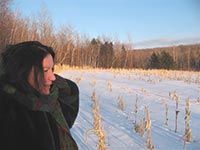Christine Sioui Wawanoloath (Abenaki – Wendat) uses the trickster’s humour to plunge us into the heart of the creation of a rather joyful world. Under the sign of a horned Shaman, a nuptial dance concludes with the separation of the sexes. The artist has created a complex mythological universe, a reinvented Genesis whose codes and signs might mislead the naïve. This is the essence of her art — revealing this essence under the guise of a playful spirituality. As Christine Sioui Wawanoloath’s double name indicates, she is a bearer of light, and at the crossroads. Her red goddess and her androgynous dancers are clear proof that laughter is sacred.
Everything she creates takes part in this marvellous first look onto a world of wonder. Her tales, illustrations, paintings and sculptures share this vibrant luminosity that makes everything she touches a revelator of the soul.
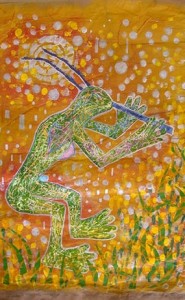
Triptyque 1 Courtisage (Triptyque 1 Courtship)
Christine Sioui Wawanoloath, 2005
Clay stamps, ink, acrylic and collage on Kraft paper, 22 x 30″
I imagined a character inspired by a petroglyph found in North America, dating back to the Stone Age. This is an androgynous character seen in profile with clear features of both sexes, a clearly defined breast and phallus. Courtisage: The character is apple green on a yellow and orange background. It plays the flute and wears long antennae that represent his connection to the cosmos. A silvery sun is shining on the left. The ground is covered with long grass.
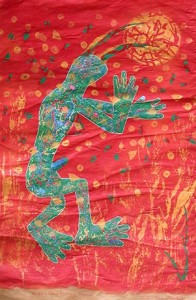
Triptyque 2 Danse nuptiale (Triptyque 2 Wedding Dance)
Christine Sioui Wawanoloath, 2004
Clay stamps, ink, acrylic and collage on Kraft paper, 22 x 30″
I imagined a character inspired by a petroglyph found in North America, dating back to the Stone Age. This is an androgynous character seen in profile with clear features of both sexes, a clearly defined breast and phallus. Wedding Dance: The character has changed its stance as if it were dancing. Now its body is dark green on a red background. Its antennae are turned towards the golden moon. Confetti is floating in the air.
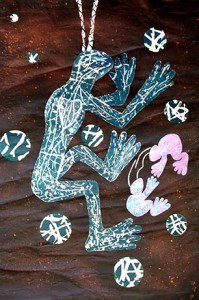
Triptyque 3 Séparation des sexes (Triptyque 3 Separation of the sexes)
Christine Sioui Wawanoloath, 2004
Clay stamps, ink, acrylic and collage on Kraft paper, 22 x 30″
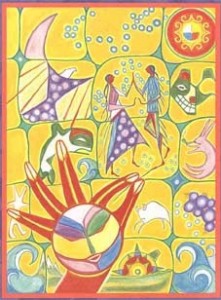
Hommage sur des perles de maïs (Homage on corn beads)
Christine Sioui Wawanoloath, 2000
Ink and pencil on cardboard, 11 x 17″
A red hand with a very colourful face at its centre is drawing a woman and a man dancing. At the right side of the drawing, a few elements typical of Canada’s First Nations surround the central figures: waves representing the two oceans, a sun-turtle rising in the east, a white buffalo running, a hare smoking a pipe, a wolf mask in the Western First Nations style, a sun with double curve motifs. At the left we can see an eagle taking flight, a West Coast style whale and a hare taken from a petroglyph. This illustration won the national prize in the First Nations section of the Indian Affairs and Northern Development competition.
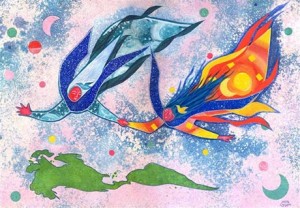
Amerikas
Christine Sioui Wawanoloath, 2004
Acrylic and collage on cardboard, 8 x 12″
I made this illustration for the conference of Aboriginal Women from North and South America that took place in Peru in 2004. Two women fly over the Americas. The older one seems to be guiding the younger.
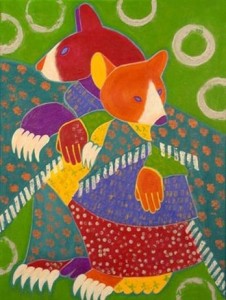
La danse des ourses (Dance of the she-bears)
Christine Sioui Wawanoloath, 2002
Acrylic on canvas, 18 x 24″
Two she-bears are doing some dance steps. The rhythm is very slow, as if they were being very cautious. The colours are vivid: orange, shades of red, cobalt blue, green, yellow and violet. This painting was done for Quebec Native Women.

Jeu d’échecs (detail) (Chess set)
Christine Sioui Wawanoloath, 2003
Deer antler, ivory and abalone mother-of-pearl
The two figures represented here are approximately 3 inches tall. These are Klooskombe who is the main mythical hero of the Wabanaki culture and Nogami who is Klooskombe’s ancestor. I represented Klooskombe as a youth with a mother-of-pearl sun shape on his head. He is holding his right hand over his heart. Nogami is also holding her right hand over her heart. She is wearing a moon-shaped headdress.
Christine Sioui and the Wabanaki tradition
Heroes of myth face off. Some are benevolent, while others do evil. Klooksombe protects and advises humans while Malsum, his wolf-headed twin brother, amuses himself creating harmful animals. They reign on the chessboard of creation. Worlds open up on the board, only to close again in the wake of cataclysms and transformations.
And when the game itself turns into a necklace , what secret power do its pieces have if not to enchant?
Klooskombe (king) is the main mythical hero in Wabanaki culture. He teaches humans the names of the constellations, technology and philosophy.
Nogami (queen) has all the wisdom in the world. She is Klooskombe’s ancestor.
Tegoak (bishop) means wave in Abenaki. The first man was born of the foam of waves.
Aki (bishop) means land in Abenaki. The first woman was born of a land plant.
Tolba (knight) means turtle in Abenaki. In Klooskombe’s world, Turtle is a friend — she is also a great storyteller.
Padôgi (rook) is the thunderbird who protects humans. He has access to the celestial spheres.
The Megumoowesoos (pawns) are little nature spirits. They are very furry and play a magic flute.
Malsum (king) is jealous of Klooskombe and seeks to undo what Klooskombe has achieved.
Pook-Jin (queen) is a witch, and Klooskombe’s enemy. She holds him captive on an island.
Lox (bishop) is Malsum’s evil creature and combines the features of three animals.
Keeganibe (bishop) is a sea mammal with a dorsal fin like a sail.
Parsardokeppiart (knight) is a name for the mammoth. He refuses to shrink as Klooskombe requests. A cataclysm will make him disappear forever from the face of the earth.
Skog (rook) is an Abenaki word for snake. Klooskombe fights a giant snake, also called a dragon or monster.
The Weewilimecq (pawns) are small magical worms with horns. They can change into snakes.
The characters are onstage. The enigmas in the theatre of the world’s creation have just begun to unfold.
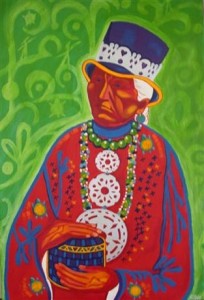
Mali Mantawas
Christine Sioui Wawanoloath, 2006
Acrylic on canvas, 24 x 36″
Mali Mantawas is a made-up name. It means ‘Marie in deep thought’. It is the portrait of an old Abenaki woman. She is wearing a red shirt on which round brooches are pinned, like the silver discs that were typical of Aboriginal fashions in the 18th and 19th centuries. She is wearing a top hat decorated with a silver crown. She proudly holds a basket in her hands. The background of the painting is green like her necklaces.
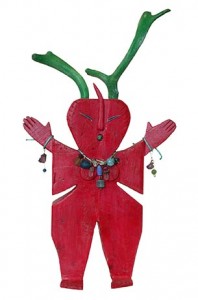
Petite déesse rouge (Little Red Goddess)
Christine Sioui Wawanoloath, 2003
Wood, antler, stones and beads, 20″ high, 10″ wide
The little red goddess is standing up straight with her arms open. She is wearing large green horns on her head. She is wearing jewellery on her wrists and her neck.
